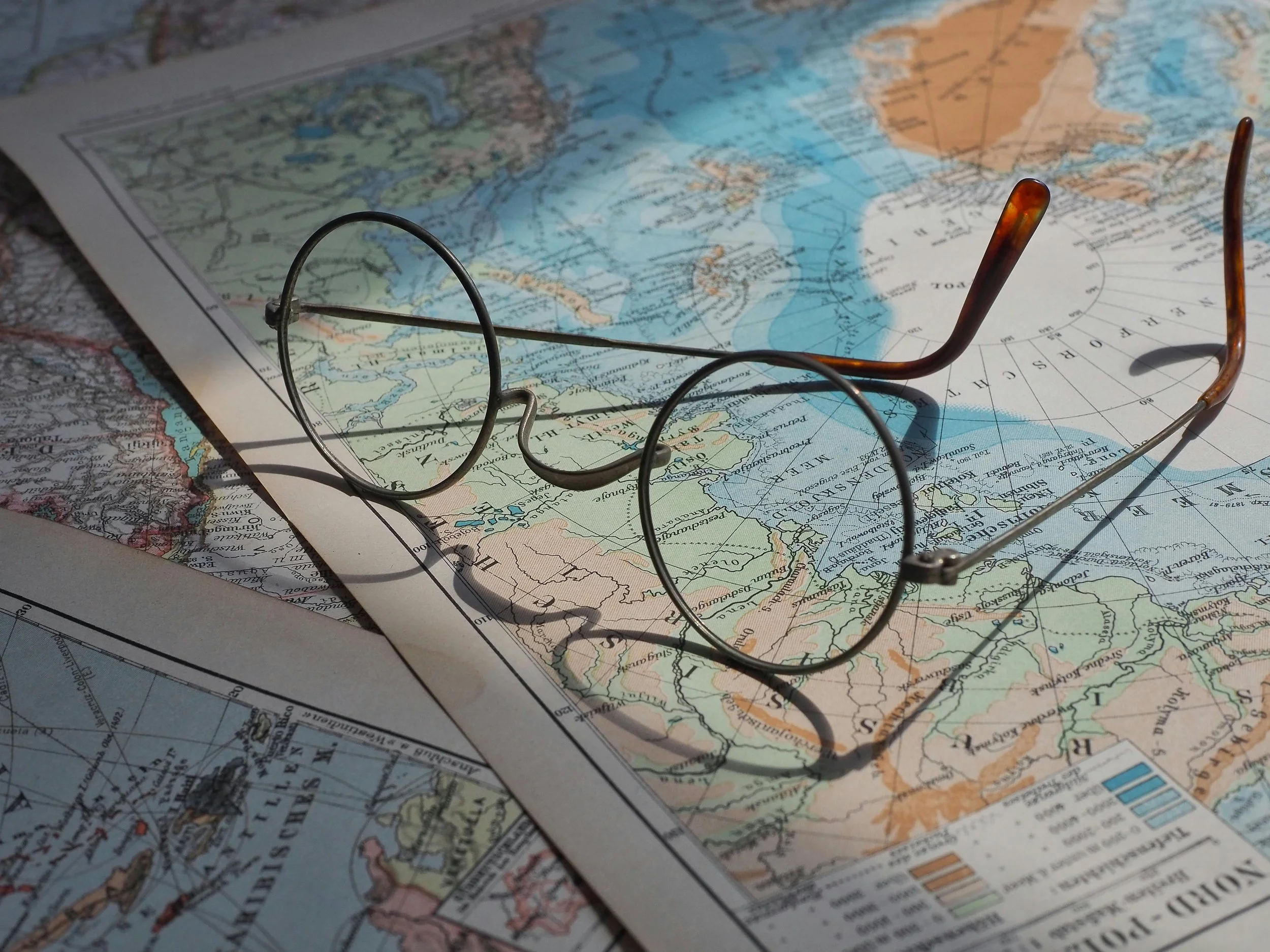
Mapping Your Setting
Learning more about the world that surrounds you.
Telling and re-telling our story is an important part of therapy. I have created this series of exercises to help you identify key elements of your personal narrative and to practice reflecting upon and authoring your life story. These exercises do not take the place of therapy, but are intended as a form of creative self-discovery and expression. As you learn more about yourself through this process, you may want to bring the insights you gain here to your work with your therapist.
Our goal in this exercise is to learn more about the world around you - the main setting of your story. To do this, we will draw up a detailed map of the terrain and social territory. This exercise borrows some general structure and worldbuilding ideas from the tabletop game The Quiet Year developed by Avery Alder as well as concepts from narrative therapy. If you have not already, you may wish to complete the theme and character exercises to first learn more about the forces that drive this world and the person who lives at its center.
To start, please grab a blank piece of paper - the bigger the better, but standard 8.5 x 11 is fine - and a pen or pencil. If you are creatively inclined, you might also want to gather some colored pencils, markers or crayons. With each of the prompts below, you will be asked a question about your world and will be asked to represent your answers on the map. You are free to use any sort of markings you like (words, symbols, drawings, etc.). All that really matters is that these markings have meaning for you. You may also want to grab a separate sheet of paper to write down notes about the world.
Please ask yourself a few questions about the world around you:
How big is your map? Does it represent a neighborhood? A city? A country? A hemisphere? The entire world?
What is the terrain like here? Is it different in different places? Please represent the terrain on the map.
What boundaries and divisions exist in this place? Are they geographical? Political? Cultural? Social? How are they enforced? Please represent these different boundaries on the map.
Have these boundaries created factions among residents? How do varying factions relate to one another? Do social hierarchies exist among factions? Please represent these factions on the map. You may also want to write faction names down in your notes.
How has this land been developed? Is it densely or sparsely populated? What has the land been used for? Please represent development levels on the map.
What natural resources exist in this place? Are they abundant or scarce? Have they been evenly distributed? Please represent abundant and scarce resources on the map. You may also want to write abundant and scarce resources down in your notes.
How do people travel through this land? Is it easy or difficult? Is it different for different groups of people? Please represent methods of transit on the map. You may also want to write methods of transit down in your notes.
What values do the people of this land hold? Are values ever in conflict with one another? Please represent various values on the map. You may also want to write community values down in your notes.
Are there mysteries or legends about this place? Does knowledge of these stories indicate a person’s membership in a particular group? Does it provide any social cache? Please represent any mysteries or legends on the map. You may also want to write mysteries and legends down in your notes.
What makes this place beautiful? What makes this place hideous? Please represent both beauty and hideousness on the map. You may also want to write notably beautiful or hideous places down in your notes.
Now that we have established some basic truths about this place, let’s work on figuring out how our main character (i.e. you) fits into the world. In this next set of prompts, we will make several references to our character and theme exercises. If you haven’t completed those activities, you might want to go back and do so now.
Where does your character live? How close or distant is it from the other items we have placed on the map so far? Please represent your home on the map.
Are there any places associated with your Adventuring Class? Does the role you play in the world require you to regularly go somewhere outside your home? If so, please represent these places on the map. You may also want to write key adventuring locations down in your notes.
Review the Social Identities you identified on the character sheet. Do any of these identities make you part of a community that occupies a physical place in this world? Do you feel connected to these places? Would you want to be? Please represent these community spaces on the map if they are not already represented. You may also want to write key social locations down in your notes.
Are the Values you listed on your character sheet different from the community values you identified earlier in this exercise? Do your personal values complement or conflict with the dominant social values of this place? Please represent your personal values on the map if they are not already represented.
Review the Allies, Organizations and Companions you listed on your character sheet. What sort of space do these individuals and groups occupy in the world? Are they centralized or scattered? How easy is it to travel to these places? Please represent your allies, organizations and companions on the map. You may also want to write key ally locations down in your notes.
Review the Key Items, Equipment and Treasure you listed on your character sheet. If these items are held in a place already represented on the map (e.g. your home), please add some additional markings to represent the item. If they are held someplace else, please represent both that place and the item held there on the map. If a key item has been lost, please represent the place it was last seen on the map and add markings to indicate the lost item. You may also want to write key item locations down in your notes.
Review the chapter headings you wrote in your Character Backstory. How did this story unfold within the world we have depicted? Is there a key event, theme or lesson from each chapter that can be represented on the map? Consider representing these events with an additional marking or signifier that indicates that these are memories and not present day objects within your world.

Mapping the problem and it’s influence.
Next, we will identify the problem you are facing and its influence on your life. We will use the goals you wrote in the theme exercise as a starting point. If you haven’t completed that section, you might want to go back and do so now.
Take a moment to review the goals you have identified. What barriers stand in the way of these goals? What overarching problem must be solved in order to meet these goals? In your notes, please write a short phrase or label you can use to describe this problem.
Imagine that this problem is a force within the world you have mapped out. In your notes, please answer the following questions: What physical form does this problem take? What does it look like? Is it big or small? How does it move?
Where does the problem live? Where does it have the most power? We can call this area the problem’s “lair.” How has the problem’s presence transformed the land around its lair? Please represent the problem and its lair on the map.
What has allowed the problem to persist here? What feeds it and gives it power? Does anyone benefit from the problem’s existence? Would anyone want to protect or defend the problem? Please represent these contributing factors on the map.
Has the problem always existed in this state? Did it develop into a problem over time? What aided in this development? Please represent the problem’s origins on the map.
What influence does the problem have on the rest of the world? Consider how the problem has influenced: the terrain, the borders and divisions within the map, your home, your relationships, your identities and the roles you play. Please represent these influences on the map. If you are using colors, you may want to choose a special color to denote the problem’s influence on the world.
Imagine that there is a special object that can vanquish this problem for good. What would that special object be and how might it work? Where is it located? What challenges exist on the road to the special object? Please represent this special object and any challenges to obtaining it on the map. You may also want to write this special object down in your notes.
When have you been able to evade or outsmart the problem - even for a brief moment? What special ability allowed you to get around the problem? Please represent your past triumphs against the problem on the map. Also, if this special ability is not already listed on your character sheet, please add it now.
Imagine that there is a place on the map where the problem cannot reach you. Not only that, this place is safe from any other problems that might arise.
Where is this place? How do you access it?
How is it protected? What makes it so safe?
What does it look like and what does it feel like being here?
Please represent this place on the map.
Again, review the goals you have identified. How will achieving each goal change the problem’s influence on this world?
Imagine each goal as a route through this map. These routes may be long or short, complicated or simple, challenging or easy but they all bring you closer towards removing the problem’s influence on your life. Overtime, these routes may need to be revised because our goals often develop and grow as we gain more information about ourselves, our needs and the challenges we face. The map you have drawn may already contain all of the steps you’ll need to take on the route towards achieving your goals. Or, you may find that a few key steps are missing. If this is the case, please represent these missing steps on your map. If you feel ready to do so, please draw your goal routes through the map. You may want to do this with an erasable writing instrument to account for future revisions. If you do not feel ready, you may wish to consult with a mental health professional to clarify your goals and how to achieve them.
If you enjoyed this activity, you may also enjoy these other exercises exploring your story’s themes and main character.


